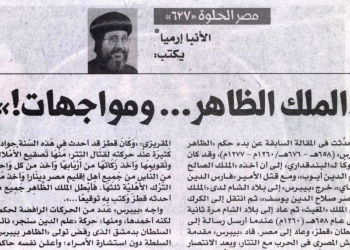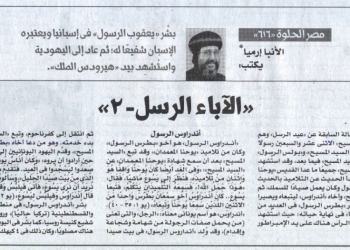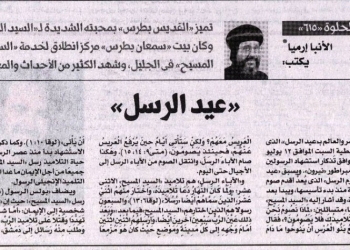Yesterday, the Christians of the East celebrated Epiphany, which is the memorial of the baptism of Jesus Christ by John the Baptist in the Jordan River: “Then Jesus came from Galilee to John at the Jordan to be baptized by him. And John tried to prevent Him, saying, ‘I need to be baptized by You, and are You coming to me?’ But Jesus answered and said to him, ‘Permit it to be so now, for thus it is fitting for us to fulfill all righteousness.’ Then he allowed Him. When He had been baptized, Jesus came up immediately from the water; and behold, the heavens were opened to Him, and He saw the Spirit of God descending like a dove and alighting upon Him. And suddenly a voice came from heaven, saying, ‘This is My beloved Son, in whom I am well pleased.’” Soon after, the ministry of the Lord Christ began among the people. The word “Baptism” refers to the immersion of a newborn in water to become a member of the Church. Epiphany is known by several names, such Feast of Lights, Theophany or Theophaneia in Greek (Appearance of God), Feast of Baptism, Feast of Washing, and Feast of Denho (according to the Syriac Church), where the word “Denho” means appearance, announcement, illumination or reveal.
Epiphany is one of the most important Christian Feasts. Saint John Chrysostom, Archbishop of Antioch, along with other fathers of the Church, said, “Epiphany is one of our primary feasts.” He also said, “Christ made Himself known to all—not then when He was born—but then when He was baptized. Until this time He was not known to the people.” Until the third century AD, Christians had celebrated Christmas and Epiphany together, after which the two feasts were separated, and were celebrated one at a time.
Among the most popular types of food eaten on Epiphany is taro, which bears a number of references to baptism. This plant is completely buried in the ground to grow as an edible plant, referring to baptism in which people are fully immersed under water (as if buried) and then rise, as happened to Christ when He was baptized in the Jordan River. Sugar cane and orange are also among the popular foods of Epiphany, as they are famous for their abundance of fluids, which is a reference to water, and for their sweet taste, a symbol of the joys of baptism. Besides, orange peels were shaped in the form of lanterns, in which candles were placed for lighting, as our ancestors used to celebrate Epiphany on waterways.
Among the customs inherited in some countries of the East is that on Epiphany eve, women were keen on preparing various desserts, such as zalabia and qatayef (types of sweet dumplings), which are two of the symbols of baptism, because the dough is dipped in oil and then rises again. Christians did not sleep on Epiphany eve until the passage of Al-Dayem Dayem (the Everlasting), meaning the Lord Christ, at midnight, to bless homes and people. The next day, people would bring water in bottles and jugs during the Epiphany Mass to be blessed by prayers. Then they themselves would be blessed with this water, and would sprinkle it in their homes, on the Christmas tree and caves, and fields, to receive the blessings from God.
Historians state that the celebration of both Christmas and Epiphany was a heartwarming Egyptian manifestation. All Egyptians celebrated them by strolling on the Nile, and thus the joy of the feast overwhelmed all Egyptians, Muslims and Christians, in a gathering marked by love. However, these celebrations stopped during the rule of the Ottoman Empire over Egypt. Al-Maqrizi said about Epiphany, “Christians began to divide their children into the water on this day, and together they plunged in the bitter cold. They called it ‘Epiphany’, and it was a great feast in Egypt.” Historian Al-Masoudi said, “Epiphany eve in Egypt was a great affair among its people, in which people do not sleep. It is on the eleventh of Tuba and the sixth of January.” Then he described the celebrations he watched with Muhammad ibn Tughj al-Ikhshid, the then Emir of Egypt, saying, “One hundred thousand people, Muslims and Christians, went to the Nile that night, some of them in boats, some from the houses near the Nile, and some were on the beaches. They did not deny their attendance. They brought everything they could, such as food, drink, clothes, gold and silver instruments, jewels, amusement games, musical instruments, and they were just having fun and playing joyfully. It was the best night in Egypt, and the most joyful. The roads were not closed. Most of the people plunged into the Nile, and claimed that this would secure them from illness and cure their diseases.” I wish you a year full of goodness and peace.
Indeed, the talk about “Beautiful Egypt” is endless.
General Bishop
Head of the Coptic Orthodox Cultural Center


 العربية
العربية











